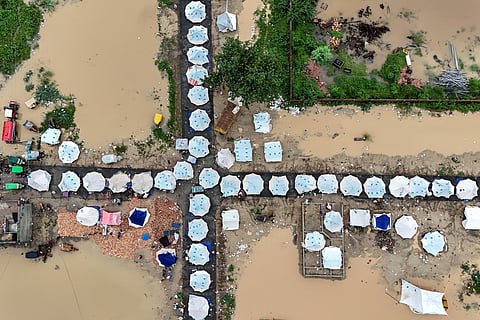Pakistan’s Punjab faces the biggest floods in its history, affecting 2 million people
It’s first time Sutlej, Chenab and Ravi have carried such high levels of water: Official

LAHORE: Pakistan’s eastern Punjab province is dealing with the biggest flood in its history, a senior official said Sunday, as water levels of rivers rise to all-time highs.
Global warming has worsened monsoon rains this year in Pakistan, one of the countries most vulnerable to climate change. Downpours and cloudbursts have triggered flash floods and landslides across the mountainous north and northwest in recent months.
Residents in eastern Punjab have also experienced abnormal amounts of rain, as well as cross-border flooding after India released water from swollen rivers and overflowing dams into Pakistan’s low-lying regions.
The senior minister for the province, Maryam Aurangzeb, told a press conference on Sunday: “This is the biggest flood in the history of the Punjab. The flood has affected two million people. It’s the first time that the three rivers — Sutlej, Chenab, and Ravi — have carried such high levels of water.”
Local authorities are using educational institutions, police, and security facilities as rescue camps, and evacuating people, including by boat, she said.
Wheat producer
Punjab, home to some 150 million people, is a vital part of the country’s agricultural sector and is Pakistan’s main wheat producer. Ferocious flooding in 2022 wiped out huge swaths of crops in the east and south of the country, leading Prime Minister Shehbaz Sharif to warn that his country faced food shortages.
Figures from Pakistan’s national weather center show that Punjab received 26.5% more monsoon rain between July 1 and August 27 compared to the same period last year.
The country’s disaster management authority said 849 people have been killed and 1,130 injured nationwide in rain-related incidents since June 26.
Pakistan’s monsoon season usually runs to the end of September.
Nearly half a million people have been displaced by flooding in eastern Pakistan after days of heavy rain swelled rivers, relief officials said on Saturday, as they carried out a massive rescue operation.
Nabeel Javed, the head of the Punjab government’s relief services, said 481,000 people stranded by the floods have been evacuated, along with 405,000 livestock.
Overall, more than 1.5 million people have been affected by the flooding.
“This is the biggest rescue operation in Punjab’s history,” Irfan Ali Khan, the head of the province’s disaster management agency, added at a press conference.
He said more than 800 boats and over 1,300 rescue personnel were involved in evacuating families from affected areas, mostly located in rural areas near the banks of the three rivers.
“No human life is being left unattended. All kinds of rescue efforts are continuing,” Khan said.
More than 500 relief camps have been set up to provide shelter to families and their livestock.
Relief camps
In the impoverished town of Shahdara, on the outskirts of the provincial capital of Lahore, dozens of families were gathered in a school after fleeing the rising water in their homes.
“Look at all the women sitting with me - they’re helpless and distressed. Everyone has lost everything. Their homes are gone, their belongings destroyed. We couldn’t even manage to bring clothes for their children,” 40-year-old cleaner Tabassum Suleman told AFP.
Rains continued throughout Saturday, including in Lahore, the country’s second-largest city, where an entire housing development was half submerged by water.
Retired shop owner Sikandar Mughal attempted to access his home but the water was still too high.
“When the situation got worse and the water level reached the garage of my house, I took my bike and ran for my life,” the 61-year-old said.
“It’s been two days now since I left. I did not even get a chance to get my clothes so that I could change.”
In mid-August, more than 400 Pakistanis were killed in a matter of days by landslides caused by torrential rains on the other side of the country, in Khyber Pakhtunkhwa, close to Afghanistan and the only province held by the opposition to the federal authorities.
In 2022, unprecedented monsoon floods submerged a third of Pakistan, with the southern province of Sindh the worst affected area.
Sign up for the Daily Briefing
Get the latest news and updates straight to your inbox



